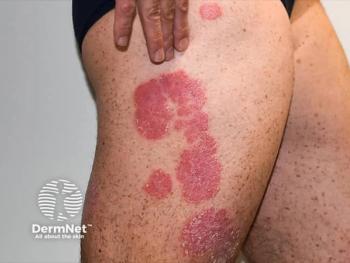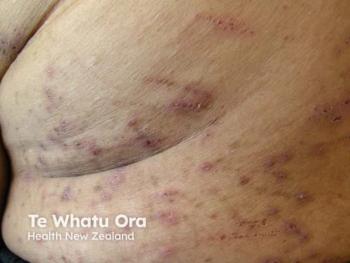
Teledermatology Preferences Among Patients with Psoriasis
Key Takeaways
- Teledermatology can improve care efficiency and patient-centeredness, especially in underserved areas, but faces adoption barriers like limited reimbursement and misalignment with patient preferences.
- Patients prefer teledermatology when consulting with their usual physician, having their concerns acknowledged, and being able to ask questions, especially for acute care scenarios.
Continuity with a known physician and rapid response times significantly increased patient willingness to use teledermatology.
Despite significant advancements in treatment options for psoriasis, treatment gaps persist. Nearly 45% of patients opt out of treatment altogether, and 60% express dissatisfaction with their current medication.1 This dissatisfaction may be partly due to strained dermatological care systems, characterized by long wait times, high caseloads, and limited consultation durations. These systemic pressures hinder effective patient-provider communication, a cornerstone of chronic disease management.2 With Germany facing a demographic shift likely to exacerbate regional disparities in care access, alternative care models have gained increasing attention.3
Background
Teledermatology has emerged as a promising solution. It offers the potential to improve care efficiency, flexibility, and patient-centeredness, particularly in underserved or rural areas. There are 2 primary modes of teledermatology: synchronous (live interactive video consultations) and asynchronous (store-and-forward messaging systems). Both formats offer unique benefits and can be employed in a variety of use cases, including acute care and follow-up visits.4
Germany’s 2020 teledermatology guidelines endorse its use specifically for psoriasis follow-ups, citing sufficient supporting evidence.4 Research further indicates high satisfaction among both patients and physicians utilizing teledermatology platforms. However, real-world uptake remains low.5 In 2023, only about 16,000 live consultations were documented, representing under 5% of dermatological patients. Barriers to broader adoption include limited reimbursement structures, especially for asynchronous care, and a possible misalignment between service design and patient preferences.6
Methods and Materials
To investigate this potential mismatch, a discrete choice experiment (DCE) was conducted with German patients diagnosed with psoriasis. The study aimed to identify patient preferences for teledermatology services and examine how various demographic, clinical, and geographic factors influence these preferences.7
“While standard-of-care was generally preferred, preference for teledermatology improved when patients were consulted by their known physician, had their concerns acknowledged and could ask questions,” researchers found.
Participants (n=221) were recruited via psoriasis patient associations and online platforms. The survey asked respondents to choose between hypothetical teledermatology care scenarios that varied by specific attributes, such as wait time, physician continuity, and the ability to ask questions. Respondents also provided data on disease severity, technological competency, privacy concerns, and healthcare utilization.
Results
Key findings from the DCE indicate a general preference for standard in-person care. However, patients favored teledermatology under certain conditions: when they could consult with their usual physician, ask questions during the interaction, and when their concerns were acknowledged. A strong preference emerged for rapid response in acute care scenarios—specifically within 24 hours. Interestingly, the mode of teledermatology (synchronous vs. asynchronous) had no significant impact on preference, possibly due to participants’ limited telemedicine experience.
Patient demographics and clinical context also influenced preferences. For example, individuals with more severe disease, higher technological competence, or lower perceived privacy risks were more likely to prefer teledermatology. Conversely, those over 63 years of age, with long-standing relationships with their physicians, or with high educational attainment were more likely to prefer traditional care—despite the convenience that telemedicine might offer.
Conclusion
This study suggests that while teledermatology is not yet a universal preference among patients with psoriasis, targeted design improvements could enhance its acceptance. Facilitating continuity of care, providing timely access—especially for acute flares—and ensuring opportunities for patient engagement appear to be critical drivers of acceptance. Structural reforms, such as broader insurance coverage and better integration into existing workflows, are necessary to scale teledermatology sustainably in Germany.
Further research is warranted to validate these findings in more diverse patient populations and to assess long-term outcomes associated with teledermatology adoption.
References
- Pilz AC, Zink A, Schielein MC, et al. Despite large choice of effective therapies: Individuals with psoriasis still seem undertreated. J Dtsch Dermatol Ges. 2021;19(7):1003-1011. doi:10.1111/ddg.14387
- van der Kraaij GE, Vermeulen FM, Smeets PMG, Smets EMA, Spuls PI. The current extent of and need for shared decision making in atopic dermatitis and psoriasis in the Netherlands: an online survey study amongst patients and physicians. J EurAcad Dermatol Venereol. 2020;34(11):2574-2583. doi:10.1111/jdv.16340
- Kis A, Augustin M, Augustin J. Regional healthcare delivery and demographic change in Germany - scenarios for dermatological care in 2035. J Dtsch Dermatol Ges. 2017;15(12):1199-1209. doi:10.1111/ddg.13379
- Augustin M, Wimmer J, Biedermann T, et al. Praxis der Teledermatologie. J Dtsch Dermatol Ges. 2018;16 Suppl 5:6-57. doi:10.1111/ddg.13512
- Mounessa JS, Chapman S, Braunberger T, et al. A systematic review of satisfaction with teledermatology. J Telemed Telecare. 2018;24(4):263-270. doi:10.1177/1357633X17696587
- Reinders P, Augustin M, Otten M. General and dermatological population's use and acceptance of digital health in Germany - a representative survey. J Dtsch Dermatol Ges. 2024;22(9):1221-1231. doi:10.1111/ddg.15454
- Reinders P, Augustin M, Stephan B, Otten M. Understanding patient priorities in teledermatology for psoriasis: A discrete choice experiment. J EurAcad Dermatol Venereol. Published online April 19, 2025. doi:10.1111/jdv.20701
Newsletter
Like what you’re reading? Subscribe to Dermatology Times for weekly updates on therapies, innovations, and real-world practice tips.


















